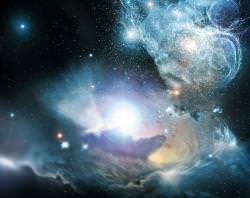What role did dark matter play in the early Universe? Since it makes up the majority of matter, it must have some effect. A team of researchers is proposing that massive quantities of dark matter formed dark stars in the early Universe, preventing the first generations of stars from entering their main sequence stage. Instead of burning with hydrogen fusion, these “dark stars” were heated by the annihilation of dark matter.
And these dark stars might still be out there.
Just a few hundred thousand years after the Big Bang, the Universe cooled enough for first matter to coalesce out of a superheated cloud of ionized gas. Gravity took hold and this early matter came together to form the first stars. But these weren’t stars as we know them today. They contained almost entirely hydrogen and helium, grew to tremendous masses, and then detonated as supernovae. Each successive generation of supernovae seeded the Universe with heavier elements, created through the nuclear fusion of these early stars.
Dark matter dominated the early Universe too, hovering around normal matter in great halos, concentrating it together with its gravity. As the first stars gathered together inside these halos of dark matter, a process known as molecular hydrogen cooling helped them collapse down into stars.
Or, that’s what astronomers commonly believe.
But a team of researchers from the US think that dark matter wasn’t just interacting through its gravity, it was right there in the thick of things. Their research is published in the paper “Dark matter and the first stars: a new phase of stellar evolution“. Particles of dark matter compressed together began to annihilate, generating massive amounts of heat, and overwhelming this molecular hydrogen cooling mechanism. Hydrogen fusion was halted, and a new stellar phase – a “dark star” – began. Massive balls of hydrogen and helium powered by dark matter annihilation, instead of nuclear fusion.
If these dark stars are stable enough, it’s possible that they could still exist today. That would mean that an early population of stars never reached the Main Sequence stage, and still live in this aborted process, sustained by the annihilation of dark matter. As the dark matter is consumed in the reaction, additional dark matter from surrounding regions could flow in to keep the core heated, and hydrogen fusion might never get a chance to take over.
Dark stars might not be so long lasting, however. The fusion from regular matter might eventually overwhelm the dark matter annihilation reaction. Its evolution into a regular star wouldn’t be halted, only delayed.
How could astronomers search for these dark stars?
They would be very large, with a core radius larger than 1 AU (the distance from the Earth to the Sun), so they might be candidates for gravitational lensing experiments. These observations use the gravity from nearby galaxies to serve as an artificial telescope to focus the light from a more distant object. This is the best technique astronomers have to find the most distant objects.
They could also be detectable by the annihilation products of the dark matter. If the nature of dark matter matches the Weakly Interacting Massive Particles theory, its annihilation would give off very specific radiation and particles in large quantities. Astronomers could look for gamma-rays, neutrinos, and antimatter.
A third way to detect them would be to search for a delay in the transition to the Main Sequence stage for the early stars. The dark stars could have interrupted this stage for millions of years, leading to an unusual gap in stellar evolution.
Perhaps these dark stars will give astronomers the evidence they need to finally know what dark matter really is.
Original Source: Dark matter and the first stars: a new phase of stellar evolution


Dear Universe Ponderers,
“With the removal of time, all things become possible.”
You must pardon me if my science is a tad out of date. ( I am an artist, and an interpreter)
OUR universe has expanded and contracted, being born-“living”-then dying- maybe millions of times. Using a “Wheels within Wheels” perspective, is there anything within our own natural evironment that simulates this kind of activity?
In our man-made environment, i can think of one thing: a computer.
It is turned off- it boots up, circuits are triggered, it gets close to the process of ‘ALL SYSTEMS GO’- then ———————
———
——
——–ERROR LINE CODE >))88711
system reboot in progress
Now I doubt that a computer will reboot a MILLION times, but it is interesting, i think.
Perhaps OUR universe represents just one tiny,infinitesimal (sp) component (in a larger
string of connectivity) , and the process of our universe expanding and collapsing again and again- well, perhaps it is (not unlike) the computer reboot-ing, trying to shake the errant Ghost In The Machine.
In a grander, macro perspective, perhaps the universe is supposed to open, and stay open ! ( like a link in a set of twinkle lights, the chain needs a curent along every ‘link’ in the chain. )
I wonder what “color” or frequency would exist in our universe if it WERE to stay open?
— Some Random Ponderings From a Lover of Energy,
Scott p Tozer
” If science could get past asking the question of HOW our atoms and molecules are attracted and relvolve around each other, keeping our various shapes of things intact, then they might ask the question of WHY. For me, the answer is clear: They’re ‘dancing’ to ‘music’ !!
Hi Frend
http://www.hypothesis-of-universe.com/en/index.php?nav=home